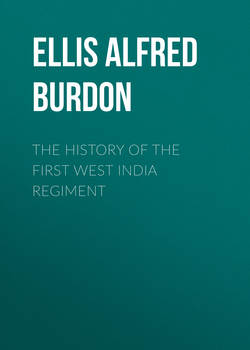The History of the First West India Regiment

Реклама. ООО «ЛитРес», ИНН: 7719571260.
Оглавление
Ellis Alfred Burdon. The History of the First West India Regiment
INTRODUCTORY CHAPTER
CHAPTER I. THE ACTION AT BRIAR CREEK, 1779 – THE ACTION AT STONO FERRY, 1779
CHAPTER II. THE SIEGE OF SAVANNAH, 1779 – THE SIEGE OF CHARLESTOWN, 1780 – THE BATTLE OF HOBKERK'S HILL, 1781
CHAPTER III. THE RELIEF OF NINETY-SIX, 1781 – THE BATTLE OF EUTAW SPRINGS, 1781 – REMOVAL TO THE WEST INDIES
CHAPTER IV. THE EXPEDITION TO MARTINIQUE, 1793 – THE CAPTURE OF MARTINIQUE, ST. LUCIA, AND GUADALOUPE, 1794 – THE DEFENCE OF FORT MATILDA, 1794
CHAPTER V. ROYAL RANGERS, COMMANDED BY CAPTAIN MALCOLM, 41ST REGIMENT
CHAPTER VI. THE CARIB WAR IN ST. VINCENT, 1795
CHAPTER VII. MAJOR-GENERAL WHYTE'S REGIMENT OF FOOT, 1795
CHAPTER VIII. THE CAPTURE OF ST. LUCIA, 1796
CHAPTER IX. THE RELIEF OF GRENADA, 1796 – THE REPULSE AT PORTO RICO, 1797
CHAPTER X. THE DEFENCE OF DOMINICA, 1805
CHAPTER XI. THE HURRICANE AT DOMINICA, 1806 – THE REDUCTION OF ST. THOMAS AND ST. CROIX, 1807 – THE RELIEF OF MARIE-GALANTE, 1808
CHAPTER XII. THE CAPTURE OF MARTINIQUE, 180935– THE CAPTURE OF GUADALOUPE, 1810
CHAPTER XIII. THE EXPEDITION TO NEW ORLEANS, 1814-15
CHAPTER XIV. THE OCCUPATION OF GUADALOUPE, 1815 – THE BARBADOS INSURRECTION, 1816 – THE HURRICANE OF 1817
CHAPTER XV. THE DEMERARA REBELLION, 1823
CHAPTER XVI. THE BARRA WAR, 1831 – THE HURRICANE OF 1831 – THE COBOLO EXPEDITION, 1832
CHAPTER XVII. THE MUTINY OF THE RECRUITS AT TRINIDAD, 1837
CHAPTER XVIII. THE PIRARA EXPEDITION, 1842 – CHANGES IN THE WEST AFRICAN GARRISONS – THE APPOLLONIA EXPEDITION, 1848
CHAPTER XIX. INDIAN DISTURBANCES IN HONDURAS, 1848-9 – THE ESCORT TO COOMASSIE, 1848 – THE SHERBRO EXPEDITION, 1849 – ESCORT TO RIO NUNEZ, 1850
CHAPTER XX. THE STORMING OF SABBAJEE, 1853 – THE RELIEF OF CHRISTIANSBORG, 1854
CHAPTER XXI. THE TWO EXPEDITIONS TO MALAGEAH, 1854 AND 1855
CHAPTER XXII. THE BATTLE OF BAKKOW, AND STORMING OF SABBAJEE, 1855.58
CHAPTER XXIII. CHANGES IN THE WEST AFRICAN GARRISONS, 1856-57 – THE GREAT SCARCIES RIVER EXPEDITION, 1859 – FIRE AT NASSAU, 1859
CHAPTER XXIV. THE BADDIBOO WAR, 1860-61
CHAPTER XXV. THE ASHANTI EXPEDITION, 1864
CHAPTER XXVI. THE JAMAICA REBELLION, 1865
CHAPTER XXVII. AFRICAN TOUR, 1866-70
CHAPTER XXVIII. THE DEFENCE OF ORANGE WALK, 1872
CHAPTER XXIX. THE ASHANTI WAR, 1873-4
CHAPTER XXX. AFFAIRS IN HONDURAS, 1874 – THE SHERBRO EXPEDITION 1875 – THE ASHANTI EXPEDITION, 1881
APPENDIX
Отрывок из книги
In the autumn of 1778, during the War of the American Independence, the British commanders in North America determined to make another attempt for the royal cause in the Southern States of Georgia and South Carolina, which, since the failure of Lord Cornwallis at the siege of Charlestown in July, 1776, had been allowed to remain unmolested. With this view they despatched Colonel Campbell, in November, from New York, with the 71st Regiment, two battalions of Hessians, three of Loyal Provincials,1 and a detachment of Artillery, the whole amounting to about 3500, to make an attempt upon the town of Savannah, the capital of Georgia. Arriving off the mouth of the Savannah River on the 23rd of December, Colonel Campbell was so rapidly successful, that, by the middle of January, not only was Savannah in his hands, but Georgia itself was entirely cleared of American troops.
It was about this time that the South Carolina Regiment, the oldest branch of the 1st West India Regiment, was raised. Numerous royalists joined the British camp and were formed into various corps;2 and the South Carolina Regiment is first mentioned as taking part in the action at Briar Creek on the 3rd of March, 1779,3 the corps then being, according to Major-General Prevost's despatch, about 100 strong. The action at Briar Creek occurred as follows:
.....
The whole American line now advanced to within three hundred yards of the works, and a general engagement began, which was maintained with much courage and steadiness on both sides. At length the regiment of Hessians on the British left gave way, and the Americans, in spite of the obstinate resistance of the two Carolina regiments, were on the point of entering the works, when a judicious flank movement of the remainder of the 71st checked the advance; and General Lincoln, apprehensive of the arrival of British reinforcements from the island, drew off his men, and retired in good order, taking his wounded with him.
The battle lasted upwards of an hour. The British had 3 officers and 19 rank and file killed, and 4 officers and 85 rank and file wounded. The South Carolina Regiment had Major William Campbell and 1 sergeant killed, 1 captain, 1 sergeant, and 3 rank and file wounded.5 The Americans lost 5 officers and 35 men killed, 19 officers and 120 men wounded.
.....